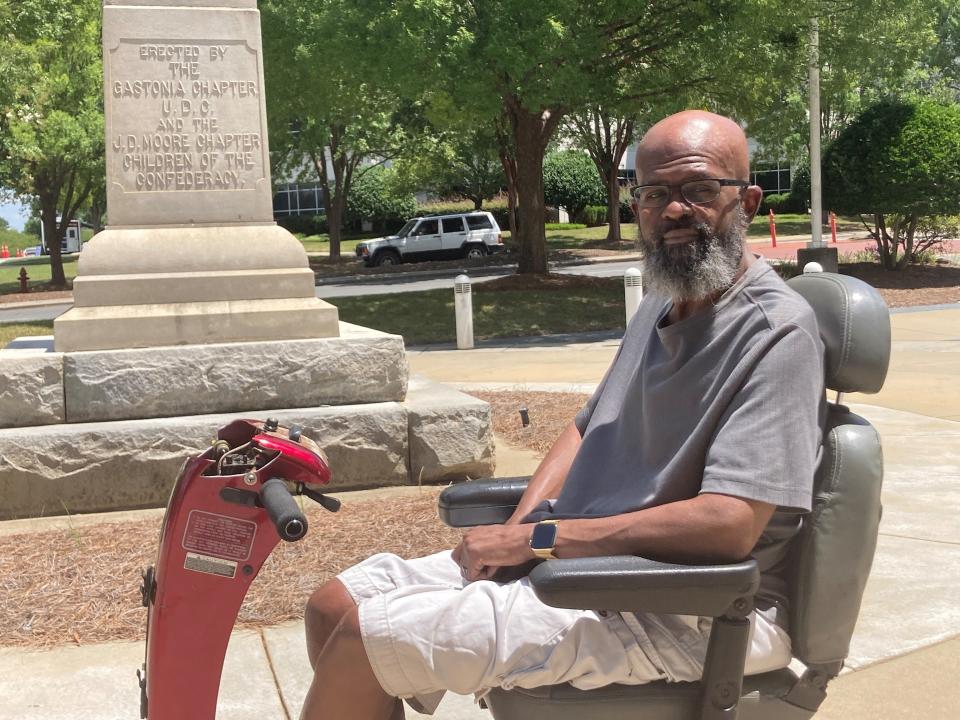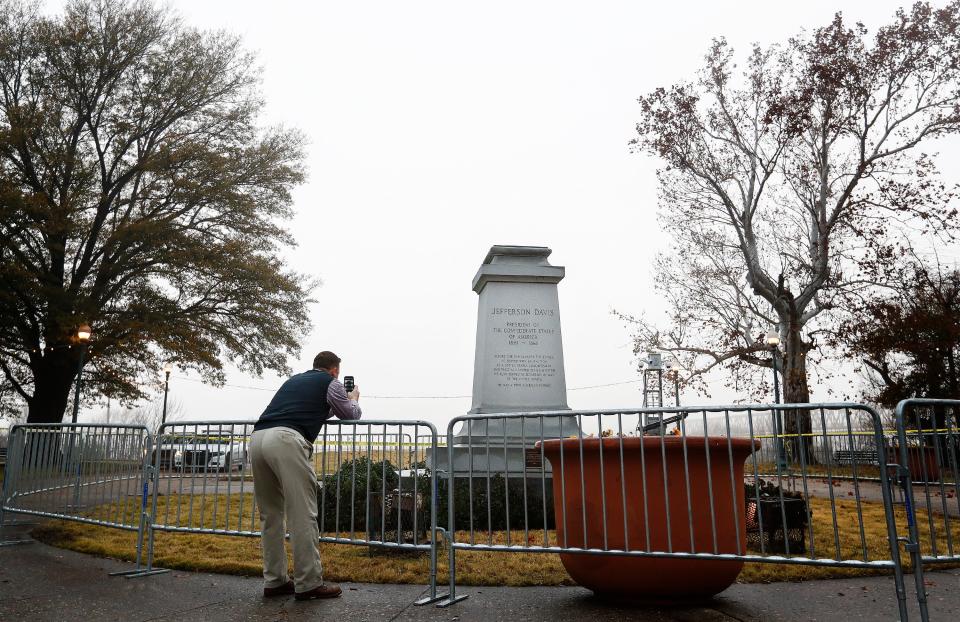How GOP lawmakers are pushing for Confederate monuments to be (legally) set in stone
For over a century, a life-size statue of a Confederate soldier has stood atop a towering monument in Fort Smith, Arkansas.
The city administrator had considered removing the monument for years. Then the murder of George Floyd, a Black man, by white police officers in Minneapolis in 2020 ignited a national conversation about Confederate monuments and sparked new calls to take it down. A local construction company even offered to help.
“This statue is a clear and present ode to the values of the Confederacy that we do not share,” residents wrote in a petition to the city.
But before local leaders could decide its fate, the Arkansas Legislature revoked their power.

Citing the “vandalism” of monuments, Republican state lawmakers passed a law in 2021 that prevents Fort Smith from removing its monument and supplants local control over dozens of other statues across the state.
Arkansas is one of many Southern states that have passed historic preservation laws to strip local leaders of the power to take down Confederate monuments in their communities. Bills in former Confederate states such as Texas and Florida were introduced in Republican-controlled legislatures this year. Now, similar bills are appearing in states that were not part of the Confederacy, including New York and Pennsylvania.
In the past decade, a USA TODAY review found, legislators in at least 20 states have proposed more than 100 bills that would limit changes to hundreds of Confederate monuments across the United States. Some of these “statue statutes” propose harsh financial penalties or even criminal charges against municipalities that remove monuments. Others would create complex approval systems that ultimately let state leaders decide the fate of monuments.
Attorneys, researchers, and legal experts say such laws don’t just affect cities' control over monuments – they are part of a larger attempt to erode the power of blue cities in red states.
“It's happening all across the country in states with a Republican-controlled legislature,” said Abe Rubert-Schewel, who is representing the NAACP in a North Carolina monument case. “They are passing laws to control what the urban centers, which are Democratically controlled, can do.”
Monument protection arguments often misrepresent history
Frequently cited as “protecting history” and “Southern heritage,” monument protection laws have been used to defend statues, plaques and memorials that honor a legacy of racism and oppression, historians say.
“Memorials to the Confederacy were intended, in part … to intimidate African Americans politically and isolate them from the mainstream of public life,” wrote the American Historical Association in a statement on Confederate monuments in 2017. Many of these monuments still stand outside courthouses and government offices where they were erected decades ago.
Most memorials to Confederate soldiers and leaders were constructed in the early 20th century during a period of segregation and racial violence, not in the aftermath of the Civil War, according to data from the Southern Poverty Law Center.

When a statue of a Confederate soldier, much like the statue in Fort Smith, was dedicated in 1912 in Gaston County, North Carolina, the state’s attorney general told the crowd that the state "stood for the integrity of a whole civilization and a white race."
That’s not a sentiment Scotty Reid, a Black veteran, wants to be reminded of outside his community’s courthouse.
“These things send a message, and it’s not a message of justice,” Reid told the Gaston Gazette in 2020. “That monument is just out of place there.”
Efforts to remove monuments are as old as the monuments themselves, according to the Southern Poverty Law Center, but they have expanded in recent years.
In June 2015, a white supremacist who had been photographed with the Confederate flag shot and killed nine Black worshippers in their church in Charleston, South Carolina. The attack prompted cities to examine their Confederate icons anew and sparked a national effort to dismantle Confederate memorials. The law center counted five monuments taken down in 2015 and 2016.
As the nation grappled with the aftermath of the Charleston massacre, the removal of a Confederate monument in Charlottesville, Virginia, became the flashpoint for more violence.
In 2017, the City Council voted to dismantle a larger-than-life statue of Confederate General Robert E. Lee from a park in the middle of the city. As members of right-wing groups gathered to protest its removal, one of them drove a car into counterprotesters, killing one and injuring 19. The violence added fuel to a growing movement to take down monuments: 15 more came down in 2018 and 2019.
Calls to do away with Confederate monuments peaked after Floyd’s murder in May 2020. In the seven months after his death, 57 came down across the United States – the most in any year. Monument removals have continued but at a slower rate.
As protesters fought over the fate of Confederate monuments in cities, a different battle has played out in state legislatures across the country.
Confederate symbols: This map, last updated in 2022, shows the locations of monuments, roads and buildings dedicated to the Confederacy and its leaders. Click here to see the full map.
Statue statutes introduced from Texas to New York
Six states have passed laws in the past decade to prevent the removal, renaming or relocation of historic monuments: Alabama, Georgia, North Carolina, Tennessee, Ohio and, most recently, Arkansas. Mississippi and South Carolina have had such laws for decades.
USA TODAY found that at least 117 bills that would limit local control over monuments have been introduced since 2013. Four in 5 bills about protecting historic monuments and memorials were introduced in Southern states. But such efforts are not limited to states that belonged to the former Confederacy.
Earlier this year, Republican legislators in New York introduced the Veterans’ Memorials Preservation Act to protect monuments constructed to honor veterans of any conflict or war engaged in by a state of the United States. Attempts to introduce the act in 2013 and 2015 had stalled in the New York Assembly, which is controlled by Democrats, and it’s possible the most recent bill may suffer the same fate.
A similar proposal has appeared repeatedly in Pennsylvania’s State Senate. While Democratic lawmakers called for the removal of Confederate monuments in the wake of the Black Lives Matter protests, Republican lawmakers tried to require legislative approval to take down monuments. The bill has been referred to the Senate Judiciary Committee, where two similar bills have died.
Despite their lack of success, lawmakers have demonstrated an appetite for bills like these, even in Northern states with relatively few monuments. These efforts have been led by Republicans, who introduced nearly all the bills USA TODAY reviewed. Only states with Republican-controlled legislatures have passed monument protection laws.
In West Virginia, Republican lawmakers have introduced more than a dozen bills since 2016 to prohibit altering or removing any monuments on public property. The state is home to just nine memorials, compared with more than 100 in neighboring Virginia, according to Southern Poverty Law Center data last updated in 2022. West Virginia broke away from Virginia during the Civil War, in part in opposition to slavery.
The proposed laws would give the power to issue permits for alterations to the West Virginia State Historic Preservation Office – a state agency overseen by an unelected official directly appointed by the governor.
Although Idaho and Oklahoma did not become states until after the Civil War, legislators in both have tried to prohibit monument removal or relocations. Like West Virginia, the bills grant historical commissions the ability to unilaterally determine the fate of Confederate monuments on public property.
Tennessee's statute has become a model for other states
That’s a model Tennessee legislators pioneered when they passed the state’s Heritage Protection Act in 2013. It prohibits removing monuments on public property but grants the nine-member Tennessee Monuments and Memorials Commission the power to make exceptions.
“The historical commission process tricks people into thinking that cities have control when it’s actually the state,” said Sage Snider, a recent graduate from Vanderbilt Law School who studies Confederate monument law.
States can try to ban monument removal, but Snider explained that the commission model allows states to create an illusion of representation. Having a historical commission falsely suggests that there is "an outlet for local energy,” even though commission members are not actually accountable to local voters, Snider said.
Tennessee lawmakers are seeking to impose outright restrictions.
The city of Memphis circumvented the Heritage Protection Act by transferring possession of a monument to a nonprofit, which promptly dismantled it in 2017. Afterward, legislators threatened to impose new rules that would withhold state funding from public entities that sell memorials without approval.

State legislators have also repeatedly tried to hold public officials directly accountable for monument removal by making violations a felony and an impeachable offense.
Those bills failed in the Tennessee Senate, but Republican legislators continue to push for restrictions. A bill now under consideration would impose a fine of $10,000 a day on public officials who participate in the removal or renaming of a monument or building.
Many bills ambiguous about the Civil War and the Confederacy
Though bills in Louisiana, Georgia and Virginia specifically mention Confederate monuments, others use more subtle wording. Many bills refer to the Civil War as the “War Between States.” Some bills do not specify which monuments are protected at all, opting instead to prevent the removal of any “historically significant” memorial or monuments “more than 40 years old.”
Legislators have used this ambiguity to implicitly protect Confederate monuments. In 2016, House Republicans in Oklahoma removed wording from a bill that limited protection to monuments of conflicts after World War I. The revised bill also would have protected monuments from the Civil War, which took place 40 years before Oklahoma became a state
Other lawmakers said they could “imagine no other practical purpose” for the bill but to prevent the removal of Confederate monuments.
“What American historical figures are under attack except for possibly Confederate generals?” then- state Sen. David Holt, a Republican, told the Oklahoman newspaper. The bill was not enacted.
Experts say Republican legislators are also trying to hide the purpose of these bills in innocuous titles like Veterans’ Heritage Protection Act and Soldiers' and Heroes' Monuments and Memorials Protection Act. North Carolina legislators enacted the Cultural History Artifact Management and Patriotism Act of 2015, which prohibits taking down state-owned “remembrances,” shortly after the Charleston church shooting prompted the removal of Confederate statues in other states.
“They know that if they had named it the ‘Confederate Heritage Protection law,’ it would’ve been harder to pass and it would’ve been harder to justify to constituents,” said Rubert-Schewel, the North Carolina civil rights attorney.
Despite these existing laws and the threat of new restrictions, communities still find ways to bring down Confederate monuments.
Cities are finding ways around monument-removal bans
Some cities, like Memphis, have circumvented rules by selling monuments to nonprofits and adding signs to explain the statues in the context of history.
Others have openly defied monument protection acts. A mayor in North Carolina livestreamed the demolition of a Confederate memorial in defiance of state law. Birmingham, Alabama, obscured and eventually removed an obelisk despite threats and fines from the state. Protesters at the University of North Carolina toppled a Confederate statue when university officials ignored calls to dismantle the monument.
Cities also are testing novel legal strategies in monument removal cases. Some lawyers portray the protests that monuments attract as a public safety concern that justifies taking them down. Others may argue that the presence of a monument violates residents’ right to a safe workplace. And courts have overturned some laws for unconstitutionally restricting the speech of towns and cities.
This article originally appeared on USA TODAY: Confederate monument removal barred under some new state laws

